-
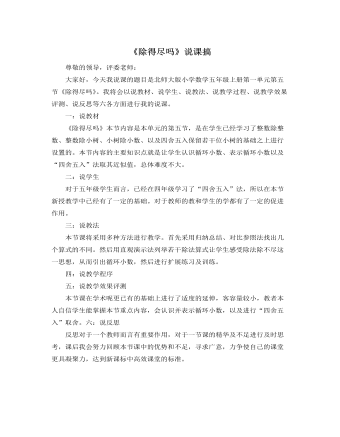
北师大版小学数学五年级上册《除得尽吗》说课稿
尊敬的领导,评委老师:大家好,今天我说课的题目是北师大版小学数学五年级上册第一单元第五节《除得尽吗》。我将会以说教材、说学生、说教法、说教学过程、说教学效果评测、说反思等六各方面进行我的说课。一:说教材《除得尽吗》本节内容是本单元的第五节,是在学生已经学习了整数除整数、整数除小树、小树除小数、以及四舍五入保留若干位小树的基础之上进行设置的。本节内容的主要知识点就是让学生认识循环小数、表示循环小数以及“四舍五入”法取其近似值,总体难度不大。二:说学生对于五年级学生而言,已经在四年级学习了“四舍五入”法,所以在本节新授教学中已经有了一定的基础。对于教师的教和学生的学都有了一定的促进作用。
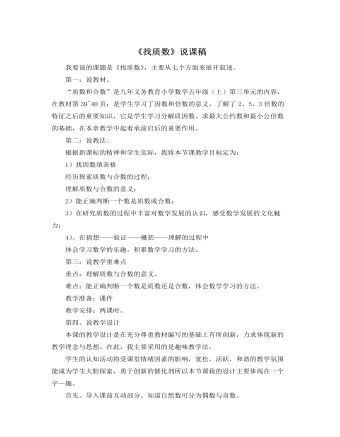
北师大版小学数学五年级上册《找质数》说课稿
第一:说教材。“质数和合数”是九年义务教育小学数学五年级(上)第三单元的内容,在教材第39~40页;是学生学习了因数和倍数的意义,了解了2、5、3倍数的特征之后的重要知识,它是学生学习分解质因数、求最大公约数和最小公倍数的基础,在本章教学中起着承前启后的重要作用。第二:说教法:根据新课标的精神和学生实际,我将本节课教学目标定为:1)找因数填表格经历探索质数与合数的过程,理解质数与合数的意义;2)能正确判断一个数是质数或合数;3)在研究质数的过程中丰富对数学发展的认识,感受数学发展的文化魅力;4)、在猜想——验证——概括——理解的过程中体会学习数学的乐趣,积累数学学习的方法。第三:说教学重难点重点:理解质数与合数的意义。难点:能正确判断一个数是质数还是合数,体会数学学习的方法。教学准备:课件教学安排:两课时。
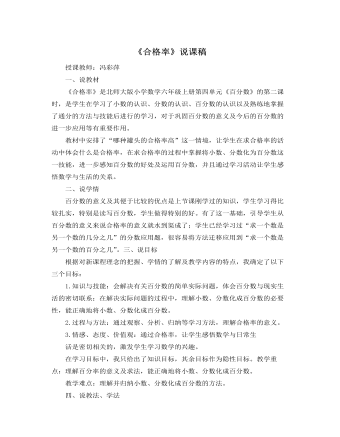
北师大版小学数学六年级上册《合格率》说课稿
四、说教法、学法我在教学中主要采用的教学方法是先学后教中的“两学两教”。辅之以多媒体教学手段(主要通过微课视频的观看学习)。本课学生的学习方法主要有:自主发现法、合作交流法、自学尝试法等。1.学生在自主探究解答例题,求两种品牌罐头的合格率时,主要采用自学尝试法,根据知识的迁移,学生能够正确求出产品合格率。2.在总结小数、分数化成百分数的方法时,学生主要采用自主发现,合作交流的方法。首先让学生观察例题板书,想一想怎样把小数、分数化成百分数,采用了“兵教兵”的方法,达到了人人参与的目的。当然,由于学生所处的文化环境,家庭背景和自身思维方式的不同,不同的学生所采用的方法也不尽相同,作为教师要尊重学生的选择,允许学生用自己喜欢的方式学习数学。五、说教学过程

人教版高中英语必修1Anne's best friend说课稿
Step 7 Language points 1.Vocabulary (1) go through (2) set down (3) a series of (4) on purpose (5) in order to (6)at dusk (7)entirely (8)face to face 2.Important sentences (1)…I’ve grown so crazy about everything to do with nature. (2)There was a time when … (3)I stayed awake on purpose until … (4)It was the first time … that I’d seen the night … (5)It’s no pleasure looking through … Purpose: 1.Master the required vocabulary and sentence structures. 2.Use them freely. Step 8 Consolidation 1.Find out the topic sentences 2.Retell the text according to the topic sentences Purpose: I want to know if my students understand the text. Step 9 Discussion Imagine you have to go into hiding like Anne and her family, what would you miss most? Giveyour reasons. Purpose: Train Ss’ oral English ability. Step 10 Homework Write an article on Friends. Purpose: 1. Improve the Ss’ writing ability. 2 Train the Ss’ ability of self—teaching and looking up information by themselves. Part 5 Blackboard design(说板书设计)Unit 1 Friendship Reading Anne’s Best Friend 1.Main idea of each paragraph: Para. 1 Anne made her diary her best friend. Para .2 Anne wrote her feelings in her diary. Para .3 Anne missed nature. Para.4 Anne saw the night face to face Para.5 Anne wanted to experience nature outdoors. 2.Listening: Exx.1 P3 3.Discussion: Exx.3 P3 Purpose: 1.Make Ss familiar with the passage 2.Make the design inductive, instructive and artistic.

人教版高中英语必修2Computers说课稿3篇
一. 教材分析1. 本单元的中心话题是“计算机(Computers)”,内容涉及计算机的发展历史,计算机的应用等。本节课是该单元的第一课时,我将Warming up, Pre-reading and Comprehending这四部分整合为一节精读课。其中。Reading部分是题为WHO AM I?的文章,以第一人称的拟人手法介绍了计算机发长演变的历史和计算机在各个领域的应用,其主旨是表达计算机的发展变化之快以及在生活中用途之广。而Warming up部分以图片的形式展现了计算机的发展历程;Pre-reading中的问题和排序分别是为了预测语篇的内容和测试学生对计算机历史了解的情况;Comprehending则通过各项练习训练学生的阅读技能,从而加深对文章的理解。可见这几部分是一个有机的整体。2. 教学目标:1) 语言目标:重点词汇及短语:abacus, calculate, calculator, PC, laptop, PDA, robot, analytical, technological, universal, mathematical, artificial, intelligent, network, explore, in common, as a result.重点句子:a. My real father was Alan Turing, who in 1963 wrote a book to describe how computers could be made to work, and build a “universal machine” to solve any mathematical problem.

人教版高中英语必修2The Olympic Games说课稿2篇
Purpose of my design:To ask the students to do these two tasks will make the Ss predict the story of this passage. As a result, it will deepen Ss’ memory of this story because they will have their own understanding of this story.Step 3. While-readingTask 1. (Individual work _____min)Skimming: ask students to skim the text and the main ideas of each paragraph in this passage. Please read it quickly and then match the sentences with the letters.Task 2. (Individual work _____min)Scanning: read the text quickly and decide the whether the following statements are true or false and give reasons.Task 3. (Pair work _____min)Listen to the tape and fill in the banks. Then read the paragraph with expression to your partner.Task4 (individual work min)Listen to the tape again and write down the main idea in one sentence.Purpose of my design: Enable students to understand the given material better by using different reading skills. And proper competition can arouse the Ss’ interest in English learning. “Task-based” teaching method is used here todevelop the Ss’ ability of communication and also their ability of co-operation will be well trainedStep 4. Post-readingTask 1. (Individual work, pair work, group work, class work; _____min)Discussion (group of 4):1. If you were Hippomenes, would you run against Atlanta?2. Do you think Hippomenes deserved to win the race? Why or why not?Step 5. HomeworkPlease read the story again carefully after class and imagine: What will happen during the race between Hippomenes and Atlanta? Who do you think will win the race? Do you think Atlanta would marry Hippomenes? Write an end for the story with thses questions.Purpose of my design: Homework is so important and necessary for to master the knowledge they learned after class. It will check whether the Ss achieve the teaching aims.Part 5 Blackboard design

人教版高中英语必修4A taste of English Humor说课稿3篇
Then I would ask them to think of a funny English or Chinese and tell it to partners. While telling stories, they can use expressions and some acting to help make the story funny. 5 minutes would be given to do this.Those stories they told there will be the material for their writing. Soletting them tell it at first is helpful. And they can make a difference between telling a funny story and writing it down. Generally speaking, it is difficult forstudents to write well because they don’t know what to write and how to write. Asking them to tell their own stories at first can help them come up with what to write.After their telling, I would invite someone to share his/her story with all of us and I would write it down on the blackboard.This example story would be used as a sample to illustrate the format of funny story. Different from a story from teacher or textbook, a story from students can obviously become a interesting material to draw students’ attention.Then I would ask the whole class to put this story into several parts. It might be a little bit difficult for them. So I would ask them to find out whether all the sentences are necessary. After delete some sentences, there are 6 sentences left behind. Then they can easily put them into three parts. After interaction with students, I would teach them the right terms for each part and conclude the format of funny story.This step is the key and difficult point in my lesson. So I mainly usetask-based teaching method in this part and the task for students was divided into several stages. With the separated difficult level, students can find there are usually three parts in writing. They can also learn to write without the unnecessary parts in the process of analyzing. And then I wouldn’t rush to tell them the right terms to them directly. Instead, I would ask them to name them by their own. A confused mind is better for acquiring knowledge.While-writing:Then I would give students 7 minutes to write down this story, without other requirements.With all the preparations in pre-writing, students’ difficulties were cleared. So it would be much easier for them to write down the story within 7 minutes. There are no other requirements because students’ first writing is actually a drafting. It would be revise and edit several times later. Writing, as a skill

人教版高中英语必修3Festivals around the World说课稿3篇
Teaching plan for Unit 1 book3Good morning, teachers. It’s my great pleasure to be here because I can share my lesson with you and I can learn a lot from it. I’ll begin my lesson from the following four parts, the teaching material, the teaching methods, the studying methods and the teaching procedure.Firstly, let me talk about the teaching material. The content of my lesson is the reading passage festivals and celebrations of Unit 1 Festivals around the world. This passage is about festivals and celebrations. By studying this passage, we’ll enable the students to know that festivals exit everywhere, and many of festivals in different countries celebrate similar ideas. As we all know, the reading passage is the center of each unit. If the Ss can learn it well, it will be helpful to make the Ss learn the rest of this unit.After studying the teaching material, I think the teaching aims are as the followings:1. Knowledge aims:(1) The Ss can master the usage of the important words andexpressions.(2)The Ss can use the __________________ (grammar) in the proper situation.Make students know about the festivals all over the world and the detail of the festivals, such as origin, content, and the date of the holiday festivals.2. Ability aims:(1) Students can talk about festivals and celebrations in English(2) To improve the student’s reading ability, especially their skimming and scanning ability.3. Emotion aims:Make the Ss know about the foreign festivals, and respect other countries’ custom.Next, let’s come to the important points and the difficult points.The important point is how to make the Ss understand the text better and the difficult point is how can they talk about it. secondly, Teaching Methods:1. task-based Language Teaching2. Computer assisted language teaching.3. question-and–answer methodThirdly, Studying Methods:

人教版高中英语必修4Working The Land说课稿3篇
Knowledge objectives:(1) to make Ss grasp the usage of words, expressions and sentence structures: statistics, struggle, thanks to, rid of, some patterns for persuasion, the “ing” form as subject and object;(2)to use learnt knowledge to persuade sb.Ability objectives:(1) to develop Ss’ reading skills(skimming, scanning, word guessing);(2) to improve Ss’ speaking, communicating and cooperating skills.Emotional objectives:to make Ss know the contribution of Yuan,and learn his spirit and his simple life time.Teaching important and difficult points:(1) some words, expressions and sentence structures mentioned above;(2)the content of the text;(3)training their reading and speaking skills.Teaching methods: CLT, TBLT,QT.Learning strategies: CLS, QLS, TBLS.Teaching procedures:Step 1 lead-in: (1) teacher plays a piece of recent news from CCTV about the harvest of the super hybrid rice, and ask students whether they know Yuan or not, and talk about him and his contribution.(2)Brain storm: let Ss describe Yuan in their minds including his appearance, his living condition and so on.Step 2 fast reading tasks:(1)teacher introduces Yuan and super hybrid rice(2)make Ss read the text as fast as possible with questions. Such as: what’s the general ideaof this passage? What’s Yuan’ dream? (skimming and scanning skill)Step 3 intensive reading tasks(1)let Ss read the text silently, find topic sentence of each paragraph and draw the difficult sentences and the knowledge what they don’t understand.(words guessing)(2)teacher and Ss talk about the important words, expressions and sentences together, and ask Ss to retell the content of the text.(summarizing and paraphrasing)(3)teacher summarize this part.(4) read again following the courseware.

人教版高中英语必修5Great scientists说课稿4篇
通过写文章梗概,培养学生综合运用语言的能力,学习用恰当的英语描述科学家的故事。这是本课的教学难点。教师可以使用完形填空的方式来帮助学生整理语篇,从而来降低难度。本课的教学重点的突破方法是:在阅读前,让学生初步了解得出科学观点所需要的基本程序,从而轻松而自然地导入文章的阅读;在阅读过程中,由易到难设计快速阅读和精读的问题,层层推进各种阅读活动,让学生对阅读内容从整体感知到细节理解,最后深层读懂整篇文章,同时加强阅读策略的指导,让每个学生都主动参与课堂教学活动,最终达到提高阅读能力的目的。Step 4 Post-readingGroup Activities四人小组共同合作,在老师的适当指导下,就以下2个问题展开讨论,让学生就所知、所学、所感和所想融入话题,然后抽若干同学代表作小组发言。1. What do you think about John Snow, and what should we learn from him?2. Cholera was 19th century disease, which two diseases are similar to cholera today? Why?

人教版高中英语必修5The United Kingdom说课稿4篇
Teaching Aims:Knowledge 1. Get the students to learn the useful new words and expressions in this section. Aims:2. Let the students learn about how the UK was formed and the four groups of invaders.1. Develop students’ reading ability and let them learn different Ability reading skills. Aims:2. Enable students to learn to talk about the United Kingdom and the Union Jack Emotional 1. Let students know more about the UK2. Develop students’ sense of cooperative learning Aims:Teaching Important Points:1. Let the students learn about the countries of the United Kingdom and the Union Jack2. Get the students to read the passage and know about how the UK was formed and the four groups of invaders.3. Have the students learn different reading skills.Teaching Difficult Ponts:1. Develop students’ reading ability.2. Enable students to talk about the United Kingdom and the Union Jack.3. Let students learn how the UK was formed geographically and historically.Teaching Methods:Showing pictures, asking, exercising, listening, reading etc.Teaching Aids:A computer,a projector and a blackboard.Teaching Procedures: 1) Show a map of the world, ask students the following questions:Where is the UK?What’s the full name of the UK?2) Ask the students work in pairs to do the quiz on Page 9.Do you want to test how many things you know about the United Kingdom? Let’s have a small test.Using the map on P9, students answer the following questions:?How many countries does the UK consist of? What are they??England is divided into three main areas. Do you know what they are? 1) Scanning (10Minutes )Let the students hold the questions asked in pre-reading and read the passagequickly and then let them do the following exercise.Join lines to the right answer.
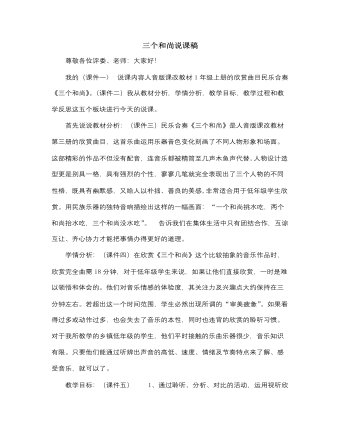
人音版小学音乐一年级上三个和尚说课稿
3.请几组同学表演这几个的场面,其他同学做评委,从模仿表演中享受学习音乐的快乐。五.课堂小结 (阶段目标:以“我的收获”(课件十)帮助学生总结所学内容,知道音乐中,不同的音乐要素可以表现不同的人物、场面)课后反思:(课件十一)在本节音乐欣赏教学中,我坚持以“听”为核心(因为音乐是一门听觉艺术),让学生“带着问题听”、“想着听”、“动着听”、“演着听”等多元化的“听”的形式。一系列“听”的任务不仅提高学生的注意力,而且提高学生“听”的兴趣与“听”的质量。而且我创造和谐的课堂气氛,积极引导学生把对音乐的内心感受大胆地用语言表达出来,让学生主动参与音乐快乐学习的实践中去,创建出有利于学生发展的生动活泼的音乐课堂情景,让学生的了解音乐,感受音乐,融入音乐。
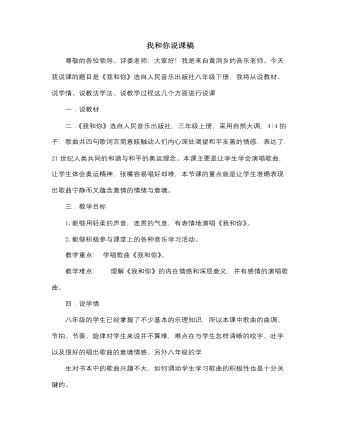
人音版小学音乐三年级上册我和你说课稿
6.欣赏第二版本。 师:关于歌曲《我和你》,还有一个鲜为人知的小故事,歌曲的原唱其实另有他人。最初作曲家陈其钢选了非常有实力的两位歌坛新秀来演唱,导演张艺谋认为一定要选择知名度很高的歌手,两人还因此大吵了一架,据说原唱的歌声更加轻盈,更加动听,你们想听一听吗?7.演唱常石磊版。 师:大家知道了,为了更好地表现出这首歌的宁静简单的气质,我们的演唱要最大限度地轻盈、柔和,就像天使的声音一样纯净。下面该轮到同学们来演唱了。注意眼睛看老师的手势,控制好气息,有表情地演唱。8.钢琴伴奏演唱。师:通过演唱,同学们肯定都感受到了这首歌曲的动人之处。下面我想请同学们站起来,想象我们来到宽敞的户外,把心放在天地间,让我们跟着钢琴伴奏,用我们纯净美妙的歌声来演绎。
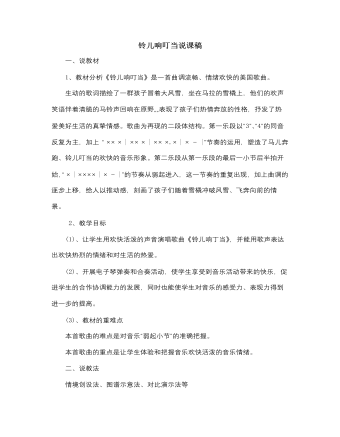
人音版小学音乐五年级下册铃儿响叮当说课稿
结合我们学校的教学条件和我自身会弹琴的优势,我还设计了课堂弹奏活动,激励学生练习好了参加圣诞联欢晚会给大家表演节目。 我把第一段的乐谱进行了简化节奏让学生弹奏,在弹奏基本完成后还设计了学生边唱边弹,并且分组让学生用电子琴自带的的打击乐器进行合奏练习,让学生在学唱的同时更加深入的体会音乐欢快活泼的节奏特点,同时让学生感受合奏的整体的音响效果,培养了学生的动手能力和集体合作能力。 六、总结 本课以歌曲《铃儿响叮当》为主要内容,听、唱、弹等教学环节都围绕他展开,各教学环节的设计易于统一,各项活动的设计均以音乐审美为核心,教学中关注段落的划分,注重引导学生的参与,体验,引导学生积极探索创造学习,展现音乐的节奏之美。
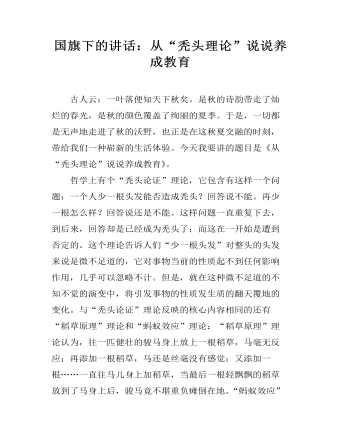
国旗下的讲话:从“秃头理论”说说养成教育
古人云:一叶落便知天下秋矣。是秋的诗韵带走了灿烂的春光,是秋的颜色覆盖了绚丽的夏季。于是,一切都是无声地走进了秋的沃野,也正是在这秋夏交融的时刻,带给我们一种崭新的生活体验。今天我要讲的题目是《从“秃头理论”说说养成教育》。哲学上有个“秃头论证”理论,它包含有这样一个问题:一个人少一根头发能否造成秃头?回答说不能。再少一根怎么样?回答说还是不能。这样问题一直重复下去,到后来,回答却是已经成为秃头了;而这在一开始是遭到否定的。这个理论告诉人们“少一根头发”对整头的头发来说是微不足道的,它对事物当前的性质起不到任何影响作用,几乎可以忽略不计。但是,就在这种微不足道的不知不觉的演变中,将引发事物的性质发生质的翻天覆地的变化。与“秃头论证”理论反映的核心内容相同的还有“稻草原理”理论和“蚂蚁效应”理论:“稻草原理”理论认为,往一匹健壮的骏马身上放上一根稻草,马毫无反应;再添加一根稻草,马还是丝毫没有感觉;又添加一根……
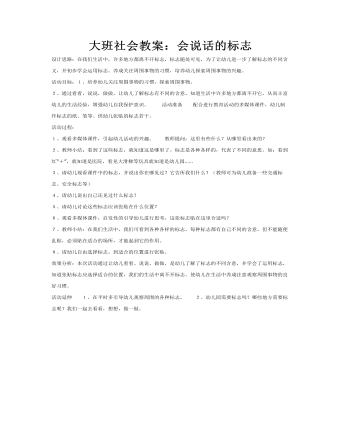
大班社会教案:会说话的标志
2、通过看看,说说,做做,让幼儿了解标志有不同的含意,知道生活中许多地方都离不开它,从而丰富幼儿的生活经验,增强幼儿自我保护意识。 活动准备 配合进行教育活动的多媒体课件,幼儿制作标志的纸、笔等、供幼儿张贴的标志若干。 活动过程:1、观看多媒体课件,引起幼儿活动的兴趣。 教师提问:这里有些什么?从哪里看出来的?2、教师小结:看到了这些标志,就知道这是哪里了。标志是各种各样的,代表了不同的意思。如:看到红“+”,就知道是医院,看见大滑梯等玩具就知道是幼儿园……3、请幼儿观看课件中的标志,并说出你在哪见过?它告所我们什么?(教师可为幼儿准备一些交通标志、安全标志等)
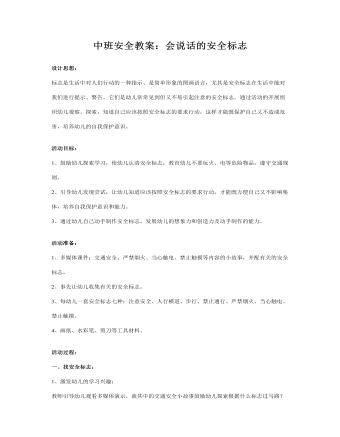
中班安全教案:会说话的安全标志
活动目标: 1、鼓励幼儿探索学习,使幼儿认清安全标志,教育幼儿不要玩火、电等危险物品,遵守交通规则。 2、引导幼儿发现尝试,让幼儿知道应该按照安全标志的要求行动,才能既方便自己又不影响集体,培养自我保护意识和能力。 3、通过幼儿自己动手制作安全标志,发展幼儿的想象力和创造力及动手制作的能力。 活动准备: 1、多媒体课件:交通安全、严禁烟火、当心触电、禁止触摸等内容的小故事,并配有关的安全标志。 2、事先让幼儿收集有关的安全标志。 3、每幼儿一套安全标志七种:注意安全、人行横道、步行、禁止通行、严禁烟火、当心触电、禁止触摸。 4、画纸、水彩笔、剪刀等工具材料。
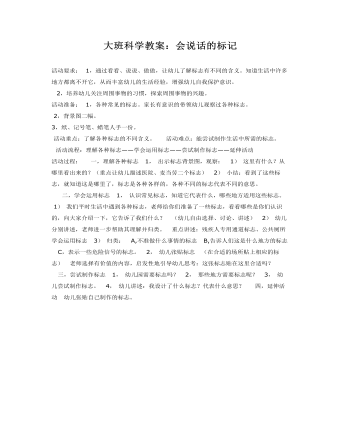
大班科学教案:会说话的标记
2,培养幼儿关注周围事物的习惯,探索周围事物的兴趣。 活动准备; 1,各种常见的标志。家长有意识的带领幼儿观察过各种标志。 2,背景图二幅。 3,纸、记号笔、蜡笔人手一份。 活动重点:了解各种标志的不同含义。 活动难点:能尝试制作生活中所需的标志。 活动流程:理解各种标志——学会运用标志——尝试制作标志——延伸活动 活动过程: 一,理解各种标志 1,出示标志背景图,观察: 1)这里有什么?从哪里看出来的?(重点让幼儿描述医院、麦当劳二个标志) 2)小结:看到了这些标志,就知道这是哪里了,标志是各种各样的,各种不同的标志代表不同的意思。

大班科学教案:会说话的标志
2.培养幼儿关注周围事物的习惯,探索周围事物的兴趣。 活动流程: 理解各种标志-->学会运用标志-->制作生活中所需的标志 材料与环境创设: 标志的背景图 活动指导: 一、理解各种标志(知道什么是标志,了解标志是各种各样的。) 1.这里有些什么?从哪里看出来的?(重点让幼儿描述医院,麦当劳和红星幼儿园三个标志) 2.小结:看到了这些标志,就知道这是哪里了。标志是各种各样的,代表了不同的意思。
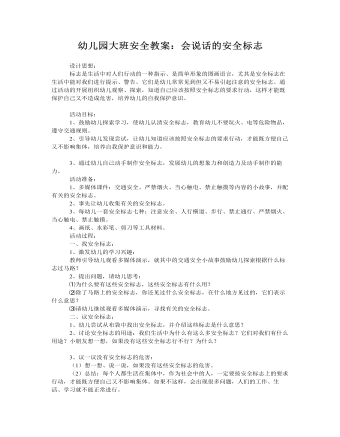
大班安全教案:会说话的安全标志
活动目标: 1、鼓励幼儿探索学习,使幼儿认清安全标志,教育幼儿不要玩火、电等危险物品,遵守交通规则。 2、引导幼儿发现尝试,让幼儿知道应该按照安全标志的要求行动,才能既方便自己又不影响集体,培养自我保护意识和能力。 3、通过幼儿自己动手制作安全标志,发展幼儿的想象力和创造力及动手制作的能力。 活动准备: 1、多媒体课件:交通安全、严禁烟火、当心触电、禁止触摸等内容的小故事,并配有关的安全标志。 2、事先让幼儿收集有关的安全标志。 3、每幼儿一套安全标志七种:注意安全、人行横道、步行、禁止通行、严禁烟火、当心触电、禁止触摸。 4、画纸、水彩笔、剪刀等工具材料。